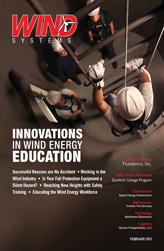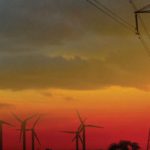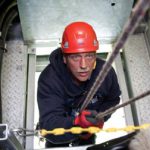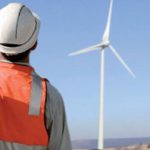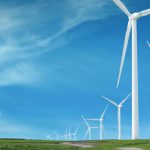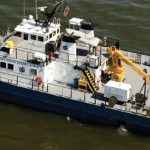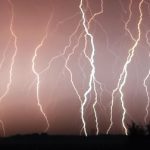Right now, North Dakota is best known for the oil boom in the western part of the state. Hydraulic fracturing technology has opened up the Bakken Oil Formation resulting in 575,490 barrels per day, bumping North Dakota up to number two in oil production in the nation after Texas.
Overshadowed at the moment by oil, North Dakota also has strong wind production. While oil derricks are common sites in the western part of the state, wind towers dot the landscape statewide. According to the American Wind Energy Association’s January 2012 report, North Dakota is ranked 6th in the U.S. for available wind resources.
The North Dakota Public Service Commission has issued permits or received letters of intent for more than 6,000MW of additional wind projects for possible development. North Dakota ranks 10th for most total installed wind capacity in the US and gets 12 percent of its total energy from the wind industry with almost 1,000 wind turbines and projects operating in 20 North Dakota counties. AWEA ranks North Dakota number one in annual wind energy potential.
Bismarck State College (BSC), a two-year community college located in the state’s capitol city, is working to fuel the workforce in traditional and renewables like wind with a wide range of energy degrees.
BSC’s energy programs have an excellent reputation nationally with graduates working in nearly every area of the industry, in the U.S. and internationally. The college rounded out its energy offerings two years ago with the launch of a renewable program that has the distinction of being the only renewable energy program in the nation offered almost entirely online.
The ability to provide a strong foundation in wind, solar, geothermal, fuel cell, biomass, hydro and tidal generation through an online platform is something the college made a priority during initial development of the program two years ago.
The program currently has more on-campus students than online students, but associate professor Reynold Miller sees a shift coming as the program becomes more well-known.
Kari Knudson, vice president for BSC’s National Energy Center of Excellence, says good jobs exist in the renewable area, but the industry is highly dependent upon production tax credits (PTCs).
“It is difficult for investors to commit to projects without knowing if the PTCs will be extended beyond 2013,” she says.
That affects both job creation and the partners that could help BSC be more flexible in the two-week on campus requirement for online students.
“Our on-campus requirement is the one thing that holds students back from enrolling I think,” Miller says. “We need to establish cooperative agreements with companies on the east coast in particular to allow our students to get the hands-on requirements they need to complete the program closer to home.”
Miller has done some outreach in this area, but is primarily focused on getting the program up and running. “We could create a real opportunity for a company to easily fill their employee pipeline by working with us,” Miller says.
Knudson is confident that the growth of jobs in the wind and solar industries also will drive program growth. The flexibility of the online offering helps. Figure 1
“Students are able to access their courses from any location. The accelerated, block style courses also work well for students that want to work while completing a degree.”
Tricia Begill is a representative case. Employed for 15 years with American Electric Power (AEP), which is headquartered in Columbus, Ohio, Begill completed her coursework entirely online earning an associate’s degree in Renewable Generation Technology from BSC in December 2012. Begill lives in Hurricane, W.V.
“The best part of taking the courses online was being able to complete my courses with my work schedule and the flexibility,” Begill said.
Begill’s interest in renewable energy stems from her exposure to the coal fired plants in West Virginia and her career at AEP.
AEP is one of the largest electric utilities in the U.S., serving over 5 million customers in 11 states. Highly diversified, the company is involved in utility operations, transmission, power generation, supplying electricity in deregulated markets and coal transportation. The company also has a substantial engagement in wind, producing nearly 38,000MW of generating capacity across a nearly 39,000 mile electricity transmission network. According to the company’s website, AEP has over a decade of experience developing, owning and operating wind projects as well as purchasing the output from projects developed by others.
For Begill, who currently works in Business Operations, her degree provides a foundation of knowledge that will help her take advantage of the many opportunities found in a large company like AEP.
“My education at BSC has helped so much, It has not only made me more knowledgeable when speaking with my customers (internal and external), I can also hear the confidence in my voice when speaking with them.”
While her current role is not wind-related, she is looking to remain at AEP and move into a wind role. “My education stacks up next to my colleagues, and I would have to say even better with the labs. I feel I’ll be ready (to move into a wind-related role) if the opportunity opens up.”
According to Miller, the renewable program is designed so that students like Begill take the same courses required for students in more traditional process plant and power plant technology programs in their first two semesters, with a “renewable spin” layered over the curriculum.
“For the Introduction to Energy Technology course for instance, those going into renewable energy are able to focus on different types of generation sources especially wind and solar,” he said.
“On a wind turbine you really have to do it all and they are ready for that when they graduate.”
Offering such technical courses online requires an investment in technology and talent to properly design the curriculum. BSC designs the online program curriculum using a team approach that includes a renewable energy job task analysis, consideration of requirements along with industry support and guidance, and instructor knowledge.
“As the only online renewable energy program in the country, our biggest challenge is to create the online courses in a way that provides hands-on elements that allows the students to accurately work with something,” Miller said. Figure 2
In establishing the program, Miller looked at templates from other programs and then designed what was needed for the very specific renewable offerings BSC had planned. “We started off with simple systems and got more complicated as we gained experience,” he said.
For the courses, designers and programmers in the BSC Curriculum Development Center (CDC) work with Miller to create the programming and animations that make for an engaging online course.
It’s a highly collaborative process that is regularly revised and updated as students and the program’s advisory board provides feedback. It begins with a new project request and continues to improve through testing and feedback.
Miller first provides a screen-by-screen narrative for the designers, providing the initial concept.
The next step is to take dozens of photos of the equipment and system being taught, and then draw each element of the machine. From there, the team story boards the presentation, and goes through every connection and possible scenario. At that point the project is placed in an online interactive format.
“We have to decide on the learning experience as we develop the curriculum,” Miller says. Do they want the student to know instantly if they are correct or have them problem solve along the way?
“The online courses are always evolving. We are always trying to enhance them. We get student feedback before each course goes online. Our goal is have the course as fluid and flexible as possible.”
Miller’s goal for the renewable curriculum is to have an utterly viable online course where students will be able to do online exactly that they’ll do on the job.
“We’re close, but not completely there,” he said. While the online curriculum is robust, online students still need to complete two weeks of hands-on lab work at BSC.
At the end of their third and fourth semesters, online students are required to participate in one week of labs. The first week is physical. Students do a climb, a climb rescue, enact safe metering practices, complete shaft alignment exercises and take part in electro hydraulic lab activities. At the end of the fourth semester, they complete labs that provide them with hands-on electric motor control and programmable logic control experience.
The advantages of the on-campus experience include the students exposure to BSC’s National Energy Center of Excellence, a state-of-the-art facility partially funded by a Department of Energy grant and filled with top-notch simulators and lab equipment funded by BSC’s many energy partners.
The student climbs take place in the building’s in-house wind tower, where students can gain experience in a controlled environment that simulates what they’ll face in the field.
“Not every student has gone to work in renewables. With ND’s economy, some drive truck in the oil fields, others take jobs in more traditional fields, but they are well prepared for careers in wind, solar and other renewable forms of energy ” Miller said. “Right now, we’re working on online courses in which students will troubleshoot circuits, connect circuits.”
The growing program has more than 20 interactive lab projects in progress at this point. “We are adding more material, additional animations and more interactions all the time,” Miller said. Miller, who has a background as a commercial wind turbine technician, is very optimistic about the future of wind in North Dakota and the nation, as well as the potential of the BSC renewable generation program.
“Wind was here before the boom. The oil boom slowed down wind progress, the variability of production tax credit is also challenging. Getting the transmission capacity to get power out of state would help us grow tremendously, but it will grow. Especially here where we can count the days the wind doesn’t blow on one hand.”



















